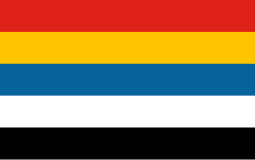Five Races Under One Union
| Five Races Under One Union | |||||||||||||||||||||||||
|---|---|---|---|---|---|---|---|---|---|---|---|---|---|---|---|---|---|---|---|---|---|---|---|---|---|
 The center flag is the Five-Colored Flag of the Republic of China. Underneath the three flags is the message: "Long live the union" (共和萬歲). | |||||||||||||||||||||||||
| Chinese | 五族共和 | ||||||||||||||||||||||||
| Literal meaning | five-race republic | ||||||||||||||||||||||||
| |||||||||||||||||||||||||
Five Races Under One Union was one of the major principles upon which the Republic of China was founded following the 1911 Revolution.[1][2][3][4] Its central tenet was the harmonious existence under one nation of what were considered the five major ethnic groups in China: the Han, the Manchu, the Mongols, the Hui (Muslims), and the Tibetans.[5]
 | |
| "Five-Colored Flag" (五色旗; Wǔsèqí) | |
| Use | Civil and state flag |
|---|---|
| Proportion | 5:8 |
| Adopted | 10 January 1912 |
| Relinquished | 29 December 1928 |
| Design | Five horizontal bands of red, yellow, blue, white and black. |
Description
[edit]This principle emphasized harmony between what were considered the five major ethnic groups in China, as represented by the colored stripes of the Five-Colored Flag of the Republic: the Han (red); the Manchus (yellow); the Mongols (blue); the Hui (Muslims) (white); and the Tibetans (black).[6]
The term "Hui" (回) here refers to all Muslims (回民, aka 穆斯林) in China as a whole regardless of ethnicity,[7] including Chinese-speaking Muslims, Turkic-speaking Uyghurs, Kazakhs, Uzbeks, Kygryzs and Tatars, Mongolic-speaking Dongxiangs and Bonans, and Iranic-speaking Pamiris, etc. The term "Muslim Territory" (回疆; Huíjiāng) was an older name for Xinjiang during the Qing dynasty.[8] It was only after the establishment of the People's Republic of China that the term "Hui" started to refer specifically to Chinese-speaking Muslims.[9][10]
Color scheme |
Red | Yellow | Blue | White | Black |
|---|---|---|---|---|---|
| Pantone | 2347 C | 7548 C | 307 C | White Color | Black Color |
| CMYK | 0-88-92-13 | 0-22-100-0 | 99-37-0-38 | 0-0-0-0 | 0-0-0-100 |
| HEX | #DF1B12 | #FFC600 | #02639D | #FFFFFF | #000000 |
| RGB | 223-27-18 | 255-198-0 | 2-99-157 | 255-255-255 | 0-0-0 |
| Chinese ethnic group represented | Han | Manchus | Mongols | Muslims | Tibetans |
History
[edit]Records from the Sui dynasty show a system of military banners using the five colors to represent the Five Elements: red for fire, yellow for earth, blue for wood, white for metal, and black for water.[citation needed] The Tang dynasty inherited this system, and has arranged the colors in a united flag according to the above order of the elements, for military use.[citation needed] During the Liao and Song periods, paintings depict the Khitan people using the same flag design.[citation needed] During the reign of the Mongol Yuan dynasty the five colors began to symbolize ethnicities (五色四夷) in a multi-ethnic state.[citation needed] In later historical periods, this "flag of the five united elements" was altered and re-adapted for military and official uses. A Qing-era painting depicting the victory of the Banners over the Muslim Du Wenxiu rebellion in Yunnan, includes a Qing military flag with the five elements arranged in the order of yellow, white, black, green and red.

After the Wuchang uprising, the Qing dynasty was replaced by the Republic of China. Prior to the adoption of the five-colored flag by the Republic, several different flags were promoted by the revolutionaries. For example, the military units of Wuchang wanted a 9-star flag featuring a taijitu,[6] while Sun Yat-sen preferred the Blue Sky and White Sun flag to honor Lu Haodong.[6]

Despite the uprisings targeting a Manchu-dominated regime, Sun Yat-sen, Song Jiaoren and Huang Xing unanimously advocated racial integration, which was symbolized by the five-color flag.[11] They promoted a view of the non-Han ethnicities as also being Chinese, despite their being a relatively small percentage of the population.[12]
The "five ethnic groups under one union" flag was no longer used after the Northern Expedition ended in 1928.
A variation of this flag was adopted by Yuan Shikai's empire and the Japanese puppet state of Manchukuo. In Manchukuo, a similar slogan was used, but the five races it represented were the Yamato (red), Han (blue), Mongols (white), Koreans (black) and Manchus (yellow). Some of its own variations also made the yellow more prominent, rather than display each color equally.
During the Second Sino-Japanese War, the flag was used by several Japanese puppet governments, including the Provisional Government of the Republic of China in the northern part of the country and the Reformed Government of the Republic of China in Central China.
Gallery
[edit]China
[edit]-
National flag, 1912–1928 (used again by the Provisional Government 1937–1940, Reformed Government 1938–1940)
-
Beiyang Army insignia, 1912–1928
-
National flag of the Empire of China, 1915–1916
-
Air force roundel, 1920–1921
-
Commander-in-chief flag of the Republic of China (Beiyang Government), 1927–1928
-
Reformed Government Army insignia, 1938–1940
-
One of the proposed national flags of the People's Republic of China, August 1949
Manchukuo
[edit]-
Manchuria Aviation Company roundel, 1931–1945
-
National flag of Manchukuo, 1932–1945
-
War ensign of Manchukuo, 1932–1945
-
Manchukuo Army insignia, 1932–1945
-
Manchukuo Air Force roundel, 1937–1945
Inner Mongolia ("four races")
[edit]-
Mongol Military Government banner, 1936–1939
-
South Chahar Autonomous Government banner, 1937–1939
-
North Shanxi Autonomous Government banner, 1937–1939
-
Flag of Mengjiang, 1939–1945
See also
[edit]References
[edit]- ^ Murray A. Rubinstein (1994). Murray A. Rubinstein (ed.). The Other Taiwan: 1945 to the present (illustrated ed.). M.E. Sharpe. p. 416. ISBN 1-56324-193-5. Retrieved 28 June 2010.
- ^ James A. Millward (2007). Eurasian crossroads: a history of Xinjiang (illustrated ed.). Columbia University Press. p. 208. ISBN 978-0-231-13924-3. Retrieved 28 June 2010.
- ^ Clyde, Paul Hibbert; Beers, Burton F. (1971). The Far East: a history of the Western impact and the Eastern response (1830–1970) (5, illustrated ed.). Prentice-Hall. p. 409. ISBN 9780133029765. Retrieved 28 June 2010.
- ^ Making of America Project (1949). Harper's magazine, Volume 198. Harper's Magazine Co. p. 104. Retrieved 13 June 2011.
- ^ Young, Louise (July 2017). "When fascism met empire in Japanese-occupied Manchuria". Journal of Global History. 12 (2). Cambridge University Press: 274–296. doi:10.1017/S1740022817000080. S2CID 164753522 – via CambridgeCore.
- ^ a b c Fitzgerald, John (1998). Awakening China: Politics, Culture, and Class in the Nationalist Revolution. Stanford University Press. p. 180. ISBN 0-8047-3337-6.
- ^ "China's Islamic Heritage". 5 March 2006.
The Nationalist government had recognised all Muslims as one of "the five peoples"—alongside the Manchus, Mongols, Tibetans and Han Chinese—that constituted the Republic of China
- ^ Suisheng Zhao (2004). A nation-state by construction: dynamics of modern Chinese nationalism (illustrated ed.). Stanford University Press. p. 171. ISBN 0-8047-5001-7. Retrieved 12 June 2011.
- ^ "中国民族". www.gov.cn. Retrieved 6 November 2024.
- ^ Lipman 1997, p. xxiii or Gladney 1996, pp. 18–20 Besides the Hui people, nine other officially recognized ethnic groups of PRC are considered predominantly Muslim. Those nine groups are defined mainly on linguistic grounds: namely, six groups speaking Turkic languages (Kazakhs, Kyrgyz, Salars, Tatars, Uyghurs and Uzbeks), two Mongolic-speaking groups (Bonan and Dongxiang) and one Iranian-speaking group (Tajiks).
- ^ Hsiao-ting Lin. [2010] (2010). Modern China's ethnic frontiers: a journey to the west. Taylor & Francis publishing. ISBN 0-415-58264-4, ISBN 978-0-415-58264-3. pg 7.
- ^ Chow, Peter C. Y. [2008] (2008). The "one China" dilemma. Macmillan publishing. ISBN 1-4039-8394-1, ISBN 978-1-4039-8394-7. pg 31.
Sources
[edit]- Gladney, Dru C. (1996). Muslim Chinese: Ethnic Nationalism in the People's Republic (2nd ed.). Harvard University Asia Center. ISBN 0-674-59497-5. (1st edition appeared in 1991)
- Lipman, Jonathan Neaman (1997). Familiar Strangers: A History of Muslims in Northwest China. University of Washington Press. ISBN 978-029-597-644-0. Retrieved 17 August 2018.

















